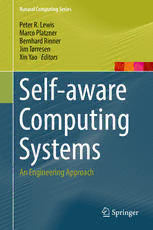
Self-aware Computing Systems: An Engineering Approach PDF
Preview Self-aware Computing Systems: An Engineering Approach
Natural Computing Series Peter R. Lewis Marco Platzner Bernhard Rinner Jim Tørresen Editors Xin Yao Self-aware Computing Systems An Engineering Approach Natural Computing Series SeriesEditors:G.Rozenberg Th.Bäck A.E.Eiben J.N.Kok H.P.Spaink LeidenCenterforNaturalComputing Advisory Board: S. Amari G. Brassard K.A. De Jong C.C.A.M. Gielen T. Head L. Kari L. Landweber T. Martinetz Z. Michalewicz M.C. Mozer E. Oja G . Pa˘un J. Reif H. Rubin A. Salomaa M. Schoenauer H.-P. Schwefel C. Torras D. Whitley E. Winfree J.M. Zurada More information about this series at http://www.springer.com/series/4190 Peter R. Lewis • Marco Platzner • Bernhard Rinner Jim Tørresen • Xin Yao Editors Self-aware Computing Systems An Engineering Approach Editors Peter R. Lewis Marco Platzner School of Engineering & Applied Science Department of Computer Science Aston University Paderborn University Birmingham, United Kingdom Paderborn, North Rhine-Westphalia Germany Bernhard Rinner Institute of Networked and Embedded Systems JimTørresen Alpen-Adria-Universität Klagenfurt Department of Informatics Klagenfurt am Wörthersee University of Oslo Austria Oslo, Norway Xin Yao School of Computer Science University of Birmingham Birmingham, United Kingdom ISSN 1619-7127 Natural Computing Series ISBN 978-3-319-39674-3 ISBN 978-3-319-39675-0 (eBook) DOI 10.1007/978-3-319-39675-0 Library of Congress Control Number: 2016942574 © Springer International Publishing Switzerland 2016 This work is subject to copyright. All rights are reserved by the Publisher, whether the whole or part of the material is concerned, specifically the rights of translation, reprinting, reuse of illustrations, recitation, broadcasting, reproduction on microfilms or in any other physical way, and transmission or information storage and retrieval, electronic adaptation, computer software, or by similar or dissimilar methodology now known or hereafter developed. The use of general descriptive names, registered names, trademarks, service marks, etc. in this publication does not imply, even in the absence of a specific statement, that such names are exempt from the relevant protective laws and regulations and therefore free for general use. The publisher, the authors and the editors are safe to assume that the advice and information in this book are believed to be true and accurate at the date of publication. Neither the publisher nor the authors or the editors give a warranty, express or implied, with respect to the material contained herein or for any errors or omissions that may have been made. Printed on acid-free paper This Springer imprint is published by Springer Nature The registered company is Springer International Publishing AG Switzerland Foreword Thisbookconsidersthedesignofnewcomputationsystemsthatareinsomeways moreresponsivetotheenvironmentandtheirownstatethancurrentsystemdesigns and aim to be more reliable through the creation of self-aware and self-expressive systems. One of the driving forces of this work is the realisation of the growth in system complexity and the difficulty of using current “standard” methods and de- signstocontinuetocreateworkingsystems.Thisiscertainlyrelevant,astheinterest inthedesignandunderstandingofcomplexcomputingsystemsintechnicalappli- cationshasbeengrowingsignificantlyinvariousresearchinitiativeslikeautonomic, organic,pervasiveorubiquitouscomputingandinthemulti-agentsystemcommu- nity.Therehavebeenmanynovelapplicationsdemonstratingawiderangeofself-* properties,aswellasstudieslookingalsoatemergingglobalbehaviourduetoself- organised local interaction. The authors of this book present the results of a large European cooperative project focusing specifically on self-awareness, which may beseenasoneoftheessentialbackgroundsfordevelopingandsupportingtheother self-*properties,whichisaddressedherebytheterm“self-expression”. Eversinceresearchershaverealisedthatmachinescouldbeprogrammedtohave increasinglyadaptivebehaviors,therehasbeenmuchresearchonhowtointroduce adaptivebehaviourandmorebiologicallikecapabilitiesintosystems–moretypes of reasoning, more types of awareness, and more types of intelligent processing. Particularly important in adaptation is that the system has the knowledge and the capabilitiesthatallowittodotheseadaptationsinnovelsituationsandatruntime. There are many examples of large-scale programmes to foster the understanding of the necessary attributes and architectures of systems capable of these adapta- tions. Hence there were programs on adapting routers and networks in real time (e.g.,DARPA’sActiveNetworks),platformsandotherplugandplayarchitectures withrobustrealtimeservices(e.g.,DARPA’sMETAprogram;Europe’sAUTOSAR (AUTomotive Open System ARchitecture), programs that worked to understand emergent behaviour and make use of it (Europe’s Organic Computing), systems withcomputationalreflectionusedforresourcemanagement(e.g.,reflectivearchi- tectures),and,ofcourse,anenormousamountofworkonmulti-agentsystemsand autonomouscomputing. v vi Foreword InthislandmarkEUproject,theseslowlydevelopingthemes,drawnfromawide diversity of fields, have been brought together and further developed with both thoughtful discussions on foundations and new research and developments in the engineeringofseveralapplicationareas. One particularly important aspect of this book is the way in which it builds up ourrepertoireofengineeringmethodsforself-awarenessbypurposelydrawingits conceptsforself-awarenessfromadiversityoffieldsanditsexamplesfromadiver- sityofapplications.Mostimportantly,theseapplicationsspanacrossdifferentlevels ofcomputationalsystems,fromagentsandapplications(interactivemusicsystems inChapter14)tomiddlewareservices(Chapter11)toadaptivenetworks(Chapter 10)andevenhardware(Chapters8,9and12.) Starting from insights into “self-awareness” achieved by other disciplines like psychology and philosophy, the notions of “computational self-awareness” and “self-expression” are systematically developed. The majority of the book focuses oncomputationalsystemsthatrequiresomeformofanticipationwherethenewal- gorithmsandmethodsareneededtoprovidetheappropriateanticipatorybehaviour. In practice, these methods can include different forms of self-awareness (such as awarenessofgoals,ofthecurrentstateandreadinessofsystemresources,ofone’s planning process and of the ordering of events), such that the system is not sim- plyreactingtoeventsandchanges,butcananticipatethem.Theideasandmecha- nisms outlined are applied to a number of interesting applications: Computational financeapplicationsusingheterogeneouscomputingclustersareinvestigatedandin- cludeself-adaptivealgorithmsthataresupportedbyhardware;low-latencyadaptive networkprocessing;run-timereconfigurablehardwareacceleration;heterogeneous computingandhardware/softwareco-processingforalgorithmictradingandrecon- figurablehardwareaccelerationofself-optimisationofreconfigurablehardwarede- signs. Self-awareness in distributed smart camera networks is considered for both single cameras at a node level and multiple camera systems within a network. In- terestingbio-inspiredmethodsareaimedatthenetworklevel,artificialpheromones areemployedtoconstructalocalneighbourhoodgraph,allowingadaptationinthe networkastopologieschange.Ahypermusicdemonstratorisconsideredasathird application. This considers various methods and techniques to enable adaptability (self-expression) in musical output. Three methods within this application are the focus of this work, each providing different input information and overall levels ofinformation:SoloJamprovidesratheroverarchingrhythmicshaping;FunkySole Musicprovideswhatmightbeconsideredmorespecific,lowerlevel,inputssuchas walkingtempo,movementtypesandfootactivity;PheroMusicconsidersmorelinks betweenmusicalsoundscapes. Thus,thebookprovidesacomprehensiveintroductiontoself-awarecomputation providingabroadrangeofnewtheoreticalbackgroundandfoundationbeforemov- ingontoconsiderdetailsofarchitecturesandtechniquestohelpdesignself-aware computational systems, from nodes to networks. Many of the problems that have beenaddressedinthisbookwillcontinuetobetimelyformanyyearstocomeand couldwellprovidethefocusofresearchstrandswithinmanyresearchfields.Partic- ular challenges remain with respect to performance, safety and security properties Foreword vii ofsuchsystems.Althoughself-awarenessissupposedtoimprovetheperformance of computational systems in complex environments, there is still a lack of formal frameworksforrigorouslyarguingaboutthebehaviourofsuchsystems. The authors are all well known in this research area and the editors, Lewis, Platzner, Rinner, Tørresen and Yao have done an excellent job in pulling together whatisanexcellentbook. LosAngeles KirstieBellman Karlsruhe HartmutSchmeck York AndyTyrrell March2016 Preface Self-awarecomputingisanemergingfieldofresearch.Itconsiderssystemsandap- plicationsabletoproactivelygatherandmaintainknowledgeaboutaspectsofthem- selves, learning and reasoning on an ongoing basis, and finally expressing them- selvesindynamicways,inordertomeettheirgoalsunderchangingconditions.The aspectstheymightbeawareofincludetheirowninternalstate,capabilities,goals, environment,behaviourandinteractions.Thepresenceofgatheredknowledgeper- mitsadvancedintelligentdecisionmakingleadingtoself-expression:thatis,effec- tive,autonomousandadaptivebehaviour,basedonself-awareness.Self-awareness andself-expressioncapabilitiesarekeytodesigningandoperatingfuturecomputing systems that will inherently and autonomously deal with high levels ofdynamics anduncertainty,heterogeneity,scalability,resourceconstraintsanddecentralisation. Conceptsofself-awarenesshavebeenestablishedinpsychology,philosophyand cognitivesciencebutarerelativelynewtocomputing.In computingsystems,our conceptsofself-awarenessandself-expressionintegrateandenhancea numberof recent approaches dealing with systems withso-calledself-*properties, e.g.,self- adaptation,self-organisationandself-healing. Thisbookisthefirstevertofocusontheemergingfieldofself-awarecomputing fromanengineeringperspective.Itfirstcomprehensivelyintroducesfundamentals for self-awareness and self-expression in computing systems, proposing the new notion of computational self-awareness. It then focuses on architectures and tech- niquesfordesigningself-awarecomputingsystemsatthenodeandnetworklevels. Finally, the effectiveness of these techniques is demonstrated on a variety of case studies.Whileanumberofbooksonrelatedtopicssuchasself-adaptionandself- organisation, and even self-awareness concepts in computing, have already been published,thisbookisuniqueasitprovidesaholisticviewofself-awarecomput- ing including its relationship with self-expression, and the process of engineering suchsystems,i.e.,athoroughunderstandingofhowtomodelandbuildself-aware computingsystemsbasedondesignpatternsandtechniques. This book targets graduate students and professionals in the fields of computer science,computerengineering,andelectricalengineering,butalsopractitionersand scientistsfromotherfieldsinterestedinengineeringsystemswithadvancedproper- ix
